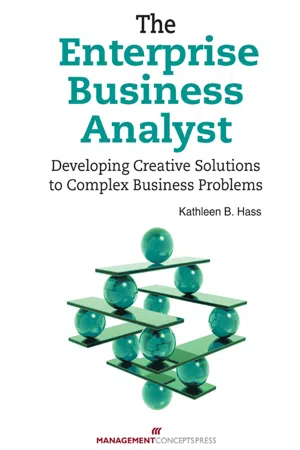![]()
PART I
Insights into the Profession of Business Analysis
In the first part of this book, we examine the foundational elements of the business analysis profession. The creative business analyst/leader will base his or her practice on these elements.
In
Chapter 1, we first look into the building blocks of the business analysis profession that have taken hold around the world, as well as the nature of the business analyst role.
In
Chapter 2, we examine the subtle and not-so-subtle ways the business analyst’s activities change as she transitions from strategic activities to more tactical project-focused activities throughout the life of a project.
In
Chapter 3, we scrutinize the emerging understanding of business and project complexity and look at how the business analyst adapts her leadership style and methods as projects become more complex.
![]()
CHAPTER 1
The Heart of the Matter—An Examination of the Profession of Business Analysis
Let’s begin by examining the entire scope of the business analysis profession and the business analyst (BA) role. The emergence of business analysis practices began in the 1980s when businesses turned their attention to improving software requirements and streamlining processes. By the early 21st century, a number of large companies that already had substantial business analysis practices called for common standards. This led to the creation of the International Institute of Business Analysis (IIBA) in 2003 (www.theiiba.org). IIBA is the fast-growing, independent, nonprofit professional association serving the field of business analysis. It is dedicated to advancing the professionalism of the occupation.
A WORD TO THE WISE
Join IIBA and your local IIBA chapter to help advance the profession. Both the international organization and local chapters offer a wealth of professional development activities to help you become a professional business analyst.
DEFINING BUSINESS ANALYSIS
IIBA has developed a standard definition and role delineation for business analysis, underscoring its emergence as a formal occupation. Since this book is about business analysis leadership, we will consistently emphasize the strategic, creative leadership role of the business analyst. As you read the definition of business analysis, note the reference to defining organizational goals and determining courses of action to achieve the goals, both very strategic in nature. IIBA defines business analysis as:
The set of tasks and techniques used to work as a liaison among stakeholders in order to understand the structure, policies and operations of an organization, and recommend solutions that enable the organization to achieve its goals.
Business analysis involves understanding how organizations function to accomplish their purposes, and defining the capabilities an organization requires to provide products and services to external stakeholders. It includes the definition of organization goals, how those goals connect to specific objectives, determining the course of action that an organization has to undertake to achieve those goals and objectives, and defining how the various organizational units and stakeholders within and outside that organization interact.1
CODIFYING BUSINESS ANALYSIS
IIBA has codified the profession in its Guide to the Business Analysis Body of Knowledge® (BABOK® Guide).2 The IIBA website describes the BABOK® Guide as:
The collection of knowledge within the profession of Business Analysis and reflects current generally accepted practices. As with other professions, the body of knowledge is defined and enhanced by the Business Analysis professionals who apply it in their daily work role. The BABOK® Guide describes Business Analysis areas of knowledge, their associated activities and the tasks and skills necessary to be effective in their execution. The BABOK ® Guide is a reference for professional knowledge for Business Analysis and provides the basis for the Certified Business Analysis Professional™ (CBAP®) Certification.3
Figure 1-1 lists knowledge areas and associated activities covered in the BABOK® Guide.
FIGURE 1-1. BABOK® Guide Knowledge Areas
In particular, the enterprise analysis activities present the business analyst with the chance, indeed the responsibility, to create and innovate. Per the BABOK® Guide:
Enterprise Analysis describes the business analysis activities necessary to identify a business need, problem, or opportunity, define the nature of a solution that meets that need, and justify the investment necessary to deliver that solution.… It describes the business analysis activities that take place for organizations to:
Analyze the business situation in order to fully understand business problems and opportunities
Assess the capabilities of the enterprise in order to understand the change needed to meet business needs and achieve strategic goals
Determine the most feasible business solution approach
Define the solution scope and develop the business case for the proposed solution
Define and document business requirements.
4 A WORD TO THE WISE
Join a study group sponsored by your local IIBA chapter. Certification instills in your current and future employers confidence in your business analysis knowledge and skills.
CERTIFYING BUSINESS ANALYSTS
IIBA has also developed a Business Analyst Certification Program unique to the profession of business analysis. Establishing a certification for business analysis has helped standardize and professionalize the practice of business analysis. Certification creates common expectations for organizations of the knowledge, skills, and competencies certified business analysts must acquire.
CERTIFIED BUSINESS ANALYSIS PROFESSIONAL™ (CBAP®)
This designation is awarded to candidates who have successfully demonstrated their business analysis expertise. This certification is awarded to business analysts who have d...













